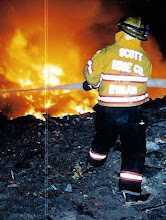Our
short answer to this burning question was “no.”
There is no question that today’s apparatus with the enclosed cab is far
safer and has gone some distance in reducing injuries and fatalities from the
days of open jump seats and riding the back step (getting dressed on the back
step wasn’t just crazy—it was stupid).
That, however, was not what we were talking about. It was more fundamental concept; that of
putting wet stuff on red stuff.
My
friend and I both started with engines without crosslays; back when all
pre-connects came off the back (one thing from the old days that seems to
slowly be regaining some favor). The
pump had two gauges. If two lines of
different lengths or sizes were in operation, the pump operator established his
pressure (yes it was always a him back then—no editorial comment intended) and
gated the other line down by experience and feel. Not the most accurate method, but it worked
well for generations. What the pump
panel didn’t look like was the cock pit of the space shuttle, which some of today’s
bear a striking resemblance to.
Individual
gauges? Love them. But flow meters, electronic valves, etc.
simply add more things to break. I won’t
even begin to talk about adding CAFS to the equation; a subject for another
day. Not needing a ladder to get up to
the deck gun was arguably an advantage of old versus new; and reaching hose
lines and ground ladders without having to climb another one.
Pumps
ran, lines and ladders were pulled, and fires went out in the old days. Simple has some attractive benefits. It breaks less often, is easier to maintain
and, arguably, to teach. I’m not
advocating a return to the open cab ’68 of yesteryear, but ask yourself
honestly if the fires are going out better, quicker, or easier with the
increased complexity of modern engines and if you’re honest, the truth is
obvious.




No comments:
Post a Comment